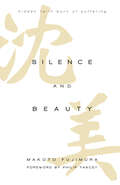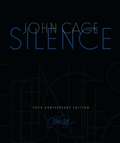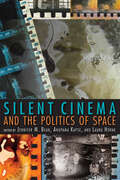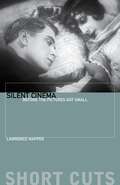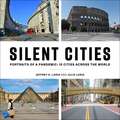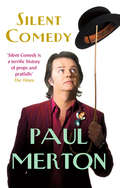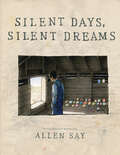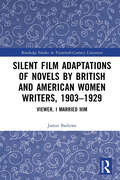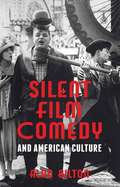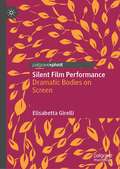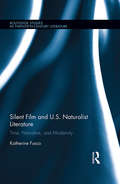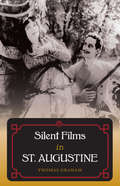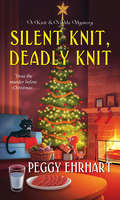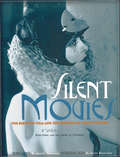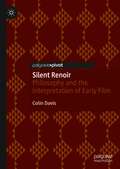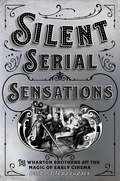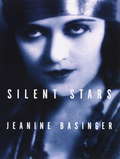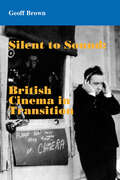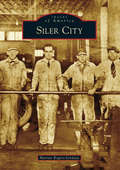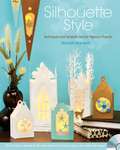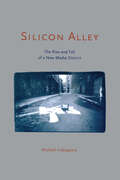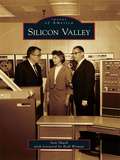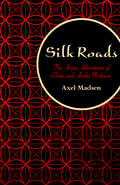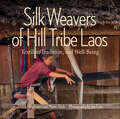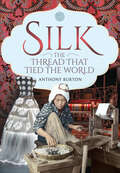- Table View
- List View
Silence and Beauty: Hidden Faith Born of Suffering
by Makoto Fujimura2017 Logos Bookstore Association Award for Christianity/Culture2017 Dallas Willard Center Book Award FinalistForeword INDIES 2016 Book of the Year Awards FinalistWorld Magazine's Best Books of 2016 Short List2016 Aldersgate Prize by the John Wesley Honors College at Indiana Wesleyan UniversityEvangelical Christian Publishers Association Top Shelf Book Cover Award14th Annual Outreach Magazine Resource of the Year, Counseling and RelationshipsMissio Alliance Essential Reading List of 2016
Silence: Lectures and Writings (50th Anniversary Edition)
by John Cage Kyle GannSilence, John Cage's first book and epic masterpiece, was published in October 1961. In these lectures, scores, and writings, Cage tries, as he says, to find a way of writing that comes from ideas, is not about them, but that produces them. Often these writings include mesostics and essays created by subjecting the work of other writers to chance procedures using the I Ching. Fifty years later comes a beautiful new edition with a foreword by eminent music critic Kyle Gann. A landmark book in American arts and culture, Silence has been translated into more than forty languages and has sold over half a million copies worldwide. Wesleyan University Press is proud to celebrate the fiftieth anniversary of the book's publication with this special hardcover edition.
Silent Cinema and the Politics of Space (New Directions in National Cinemas)
by Jennifer M. Bean, Anupama Kapse and Laura HorakIn this cross-cultural history of narrative cinema and media from the 1910s to the 1930s, leading and emergent scholars explore the transnational crossings and exchanges that occurred in early cinema between the two world wars. Drawing on film archives from around the world, this volume advances the premise that silent cinema freely crossed national borders and linguistic thresholds in ways that became far less possible after the emergence of sound. These essays address important questions about the uneven forces–geographic, economic, political, psychological, textual, and experiential–that underscore a non-linear approach to film history. The "messiness" of film history, as demonstrated here, opens a new realm of inquiry into unexpected political, social, and aesthetic crossings of silent cinema.
Silent Cinema: Before the Pictures Got Small (Short Cuts)
by Lawrence NapperSince the spectacular success of The Artist (2011) there has been a resurgence of interest in silent cinema, and particularly in the lush and passionate screen dramas of the 1920s. This book offers an introduction to the cinema of this extraordinary period, outlining the development of the form between the end of the First World War and the introduction of synchronized sound at the end of the 1920s. Lawrence Napper addresses the relationship between film aesthetics and the industrial and political contexts of film production through a series of case studies of "national" cinemas. It also focuses on film-going as the most popular leisure activity of the age. Topics such as the star system, cinema buildings, musical accompaniments, film fashions, and fan cultures are addressed—all the elements that ensured that the experience of the pictures was "big." The international dominance of Hollywood is outlined, as are the different responses to that dominance in Britain, Germany, and the USSR. Case studies seek to move beyond the familiar silent canon, and include The Oyster Princess (1919), It (1927), Shooting Stars (1927), and The Girl with the Hatbox (1927).
Silent Cities: Portraits of a Pandemic: 15 Cities Across the World
by Julie Loria Jeffrey H. LoriaA moving, recognizable look at life on lockdown and the effect the coronavirus pandemic had across the world—because every city had a story to tell, and at the end of it all, we were all in it together. In the past year, hospitals filled, highways and subways emptied, landmarks and parks were deserted, our healthcare workers became increasingly fatigued and frustrated, and nearly all human activity paused. In photographs, The Great Wall and The Colosseum look photoshopped, with no tourists in sight. This book is unique in that it creates a visual narrative to document that emptiness as a way to reflect and to find solace amid the shock. A year later, it's something we've all seen and can relate to. This is a stunning collection of the abandoned and austere sights of fifteen major cities throughout the world during the peak outbreak of COVID-19. With their fine art backgrounds and through their network of professional photographers, Julie and Jeffrey Loria worked together to capture the unprecedented lockdown conditions worldwide. The photos show a range of emotions from the physical and psychological weight of caskets being carried to a Rio cemetery, to the completely empty and eerie Times Square and Rodeo Drive, to the patriotic pride in Rome's t-shirt display honoring their Italian flag colors as a symbol of hope. The photographs are not only a reminder of the harrowing pandemic that hushed some of the world&’s greatest urban streets, but also proof that across the globe, we were all in this together. Beneath the somberness in these images, there is a hint of beauty amid the stillness, but most of all, there is the presence of hope and promise that we will thrive again. Cities featured include: New YorkJerusalemBostonTokyoParisLos AngelesRomeRio de JaneiroSan FranciscoWashington, DCLondonMiamiTel AvivMadridChicago
Silent Comedy
by Paul MertonOn the surface it may seem slightly surprising that a master of verbal humour should also be a devotee of silent comedy, but Paul Merton is completely passionate about the early days of Hollywood comedy and the comic geniuses who dominated it. His knowledge is awesome - as anyone who watched his BBC 4 series Silent Clowns or attended the events he has staged nationwide will agree - his enthusiasm is infectious, and these qualities are to be found in abundance in his book. Starting with the very earliest pioneering short films, he traces the evolution of silent comedy through the 1900s and considers the works of the genre's greatest exponents - Buster Keaton, Charlie Chaplin, Laurel and Hardy and Harold Lloyd - showing not only how each developed in the course of their career but also the extent to which they influenced each other. At the same time, Paul brings a comedian's insight to bear on the art of making people laugh, and explores just how the great comic ideas, routines, gags and pratfalls worked and evolved. His first book for ten years, this is destined to be a classic.
Silent Days, Silent Dreams
by Allen SayCaldecott Medal winner Allen Say brings his lavish illustrations and hybrid narrative and artistic styles to the story of artist James Castle.James Castle was born two months premature on September 25, 1899, on a farm in Garden Valley, Idaho. He was deaf, mute, autistic, and probably dyslexic. He didn't walk until he was four; he would never learn to speak, write, read, or use sign language.Yet, today Castle's artwork hangs in major museums throughout the world. The Philadelphia Museum of Art opened "James Castle: A Retrospective" in 2008. The 2013 Venice Biennale included eleven works by Castle in the feature exhibition "The Encyclopedic Palace." And his reputation continues to grow.Caldecott Medal winner Allen Say, author of the acclaimed memoir Drawing from Memory, takes readers through an imagined look at Castle's childhood, allows them to experience his emergence as an artist despite the overwhelming difficulties he faced, and ultimately reveals the triumphs that he would go on toachieve.
Silent Film Adaptations of Novels by British and American Women Writers, 1903-1929: Viewer, I Married Him (Routledge Studies in Twentieth-Century Literature)
by Jamie BarloweSilent Film Adaptations of Novels by British and American Women Writers, 1903–1929 focuses on fifty-three silent film adaptations of the novels of acclaimed authors George Eliot, Charlotte Brontë, Emily Brontë, Mary Shelley, Louisa May Alcott, Harriet Beecher Stowe, Willa Cather, and Edith Wharton. Many of the films are unknown or dismissed, and most of them are degraded, destroyed, or lost—burned in warehouse fires, spontaneously combusted in storage cans, or quietly turned to dust. Their content and production and distribution details are reconstructed through archival resources as individual narratives that, when considered collectively, constitute a broader narrative of lost knowledge—a fragmented and buried early twentieth-century story now reclaimed and retold for the first time to a twenty-first-century audience. This collective narrative also demonstrates the extent to which the adaptations are intertextually and ideologically entangled with concurrently released early “woman’s films” to re-promote and re-instill the norm of idealized white, married, domesticated womanhood during a time of extraordinary cultural change for women. Retelling this lost narrative also allows for a reassessment of the place and function of the adaptations in the development of the silent film industry and as cinematic precedent for the hundreds of sound adaptations of the literary texts of these eight women writers produced from 1931 to the 2020s.
Silent Film Comedy and American Culture
by Alan BiltonBilton's study of early 20th century American culture interprets the anarchic absurdity of slapstick movies as a form of collective anxiety dream, their fantastical images and illogical gags bypassing rational thought to express the unconscious fears, wishes and concerns of the modern age. Silent film comedy, with its childlike love of the illogical, the destructive and the anti-social, seems to suggest a form of comic revolt against the mechanisation and the uniformity of the machine age, but the book also charts how a new consumer culture sought simultaneously to tame and contain these energies, redirecting them in the service of a newly emergent mass culture. Not just a film history of the silent era, Bilton also provides a provocative and lively engagement with the origins of mass culture, tracing the origins of Hollywood's dream factory and alongside it the roots of our own irrational, childlike, celebrity-obsessed consumer culture.
Silent Film Performance: Dramatic Bodies on Screen
by Elisabetta GirelliThis book provides a groundbreaking exploration of silent film performance. It combines close reading of silent screen acting with theoretically informed analysis, stressing the overlap between different performative arts, such as film and stage acting, dance, mime, and pantomime. The boundary between silent and sound films is also challenged. Anna Pavlova’s acting in The Dumb Girl of Portici is read through Freud’s work on the uncanny, disability studies, and notions of intermediality. Vladimir Mayakovsky’s performance in The Young Lady and the Hooligan is approached as a silent soliloquy and a representation of loneliness. Ivan Mozzhukhin’s tour de force in The Late Mathias Pascal is discussed through a queer failure lens, while Pola Negri’s presence in Hotel Imperial is analysed with the aid of texts on wartime anxiety. Harald Kreutzberg’s stunning number in Paracelsus is examined in the light of theories of mime and pantomime, arguing for its subversive potential in a Third Reich sound film.
Silent Film and U.S. Naturalist Literature: Time, Narrative, and Modernity (Routledge Studies in Twentieth-Century Literature)
by Katherine FuscoTypically, studies of early cinema’s relation to literature have focused on the interactions between film and modernism. When film first emerged, however, it was naturalism, not modernism, competing for the American public’s attention. In this media ecosystem, the cinema appeared alongside the works of authors including Charlotte Perkins Gilman, Jack London, and Frank Norris. Drawing on contemporaneous theories of time and modernity as well as recent scholarship on film, narrative, and naturalism, this book moves beyond traditional adaptation studies approaches to argue that both naturalism and the early cinema intervened in the era’s varying experiments with temporality and time management. Specifically, it shows that American naturalist novels are constructed around a sustained formal and thematic interrogation of the relationship between human freedom and temporal inexorability and that the early cinema developed its norms in the context of naturalist experiments with time. The book identifies the silent cinema and naturalist novel’s shared privileging of narrative progress over character development as a symbolic solution to social and aesthetic concerns ranging from systems of representation, to historiography, labor reform, miscegenation, and birth control. This volume thus establishes the dynamic exchange between silent film and naturalism, arguing that in the products of this exchange, personality figures as excess bogging down otherwise efficient narratives of progress. Considering naturalist authors and a diverse range of early film genres, this is the first book-length study of the reciprocal media exchanges that took place when the cinema was new. It will be a valuable resource to those with interests in Adaptation Studies, American Literature, Film History, Literary Naturalism, Modernism, and Narrative Theory.
Silent Films in St. Augustine
by Thomas Graham“This absorbing tale, documenting the forgotten history of early moviemaking in St. Augustine, is a must-read for film enthusiasts.”—Janelle Blankenship , coeditor of European Visions: Small Cinemas in Transition “Very few people have any idea that St. Augustine played any role in early film history. This book brings St. Augustine into a much larger film conversation.”—Christina Lane, author of Magnolia “This richly detailed book tells the story of early filmmakers’ adventures in St. Augustine and captures the excitement of their moviemaking escapades.”—Kathryn Fuller-Seeley, coauthor of One Thousand Nights at the Movies: An Illustrated History of Motion Pictures, 1895–1915 “Given that the great majority of these early films are now lost, Graham makes an important contribution to the study of Florida’s image on film.”—Jan-Christopher Horak, author of Saul Bass: Anatomy of Film Design “The ‘reel’ history of Florida and its contribution to the development of American film history has been left out of mainstream textbooks and accounts. Thomas Graham’s book is a link in the chain of that history and an important addition to film scholarship.”—Susan Doll, coauthor of Florida on Film: The Essential Guide to Sunshine State Cinema and Locations “Through entertaining stories of how St. Augustine lured studios and enriched filmmaking with Henry Flagler’s railroad and architecture, Graham adds new detail to our understanding of the silent film era.”—Rita Reagan, Norman Studios Silent Film Museum Before Hollywood, when America’s rising motion picture industry was based on the East Coast, early film stars like Rudolph Valentino, Thomas Meighan, Ethel Barrymore, and Oliver Hardy made movies in St. Augustine, Florida. Silent Films in St. Augustine tells stories of the leading film producers and actors who escaped New York winters—and kept the studio doors open—in St. Augustine’s sunshine and warm weather. Scenes for more than 120 films were made in St. Augustine from 1906 to 1926 by film companies including Thanhouser, Lubin, Éclair, Pathé, Edison, Vitagraph, and Paramount. The first feature-length Frankenstein movie, Life Without Soul, was partly shot in St. Augustine. Theda Bara became a “vamp” sensation for her role in A Fool There Was. Sidney Drew acted in the genderbending A Florida Enchantment. Noted directors Edwin S. Porter, Maurice Tourneur, and George Fitzmaurice also set up shop in the beach town. Filmmakers used St. Augustine’s striking architecture to create backdrops for movies set in exotic foreign locales. The famous Castillo de San Marcos, the stone houses on the narrow streets, and Henry Flagler’s Spanish Renaissance palace hotels were reimagined as Spain, Italy, France, Egypt, Arabia, South Africa, Brazil, and Hawaii. Residents of St. Augustine loved seeing film teams in action on their streets and would gather around the camera to watch the actors and marvel at the outlandish costumes. Cast as extras in larger productions, locals packed theater houses to catch a glimpse of themselves and their neighbors on the screen. Describing the lavish sets, theatrical action, and New York movie personalities that filled St. Augustine, Thomas Graham evokes an intensely creative time and place in the history of American moviemaking.
Silent Knit, Deadly Knit (A Knit & Nibble Mystery #4)
by Peggy EhrhartWhen murder silences the Christmas cheer in charming Arborville, New Jersey, Pamela and her Knit and Nibble pals must unravel the most bone-chilling mystery this side of the North Pole . . . Pamela has been in merry spirits since her artsy daughter Penny returned home from college for the holidays. But their mother-daughter bonding time gets cut short when a terrified Penny stumbles upon the dumped body of Millicent Farthingale, a wealthy craft shop owner who was popular for all the wrong reasons. From a scheming business partner to a seedy husband several years her junior, Millicent attracted scammers so in love with her assets, they’d toss her down a chimney to get their paws on them. Now, with only a hand-knit red scarf connecting the killer to the crime, Pamela and the Knit and Nibblers could use some extra creativity as they find out who’s really naughty or nice in Arborville—because going up against a looming culprit is DIY or die! Knitting tips and delicious recipe included!
Silent Movies: The Birth of Film and the Triumph of Movie Culture
by Peter Kobel Martin Scorsese Kevin BrownlowA gorgeous, lavish history of silent movies - with more than 400 amazing images - captures the birth of film and icons like Chaplin, Garbo, Clara Bow, and Valentino. Drawing on the extraordinary collection of The Library of Congress, one of the greatest repositories for silent film and memorabilia, Peter Kobel has created the definitive visual history of silent film. From its birth in the 1890s, with the earliest narrative shorts, through the brilliant full-length features of the 1920s, SILENT MOVIES captures the greatest directors and actors and their immortal films. SILENT MOVIES also looks at the technology of early film, the use of color photography, and the restoration work being spearheaded by some of Hollywood's most important directors, such as Martin Scorsese and Francis Ford Coppola. Richly illustrated from the Library of Congress's extensive collection of posters, paper prints, film stills, and memorabilia-most of which have never been in print-SILENT MOVIES is an important work of history that will also be a sought-after gift book for all lovers of film.
Silent Renoir: Philosophy and the Interpretation of Early Film
by Colin DavisJean Renoir (1894-1979) is widely regarded as one of the most distinguished directors in the history of world cinema. In the 1930s he directed a string of films which stretched the formal, intellectual, political and aesthetic boundaries of the art form, including works such as Le Crime de Monsieur Lange, La Grande Illusion, La Bête humaine and La Règle du jeu. However, the great director’s early work from the 1920s remains almost completely unknown, even to film specialists. If it is discussed at all, it is often seen to be of interest only insofar as it anticipates themes and techniques perfected in the later masterpieces. Renoir’s films of the 1920s were sometimes unfinished, commercially unsuccessful, or unreleased at the time of their production. This book argues that to regard them merely as prefigurations of later achievements entails a failure to view them on their own terms, as searching, unsettled experiments in the meaning and potential of film art.
Silent Serial Sensations: The Wharton Brothers and the Magic of Early Cinema
by Barbara Tepa LupackThe first book-length study of pioneering and prolific filmmakers Ted and Leo Wharton, Silent Serial Sensations offers a fascinating account of the dynamic early film industry. As Barbara Tepa Lupack demonstrates, the Wharton brothers were behind some of the most profitable and influential productions of the era, including The Exploits of Elaine and The Mysteries of Myra, which starred such popular performers as Pearl White, Irene Castle, Francis X. Bushman, and Lionel Barrymore. Working from the independent film studio they established in Ithaca, New York, Ted and Leo turned their adopted town into "Hollywood on Cayuga." By interweaving contemporary events and incorporating technological and scientific innovations, the Whartons expanded the possibilities of the popular serial motion picture and defined many of its conventions. A number of the sensational techniques and character types they introduced are still being employed by directors and producers a century later.
Silent Stars
by Jeanine BasingerFrom one of America's most renowned film scholars: a revelatory, perceptive, and highly readable look at the greatest silent film stars -- not those few who are fully appreciated and understood, like Chaplin, Keaton, Gish, and Garbo, but those who have been misperceived, unfairly dismissed, or forgotten. Here is Valentino, "the Sheik," who was hardly the effeminate lounge lizard he's been branded as; Mary Pickford, who couldn't have been further from the adorable little creature with golden ringlets that was her film persona; Marion Davies, unfairly pilloried in Citizen Kane; the original "Phantom" and "Hunchback," Lon Chaney; the beautiful Talmadge sisters, Norma and Constance. Here are the great divas, Pola Negri and Gloria Swanson; the great flappers, Colleen Moore and Clara Bow; the great cowboys, William S. Hart and Tom Mix; and the great lover, John Gilbert. Here, too, is the quintessential slapstick comedienne, Mabel Normand, with her Keystone Kops; the quintessential all-American hero, Douglas Fairbanks; and, of course, the quintessential all-American dog, Rin-Tin-Tin.This is the first book to anatomize the major silent players, reconstruct their careers, and give us a sense of what those films, those stars, and that Hollywood were all about. An absolutely essential text for anyone seriously interested in movies, and, with more than three hundred photographs, as much a treat to look at as it is to read.
Silent to Sound: British Cinema in Transition
by Geoff BrownSilent cinema was never silent. But from the mid-1920s onwards, the 'sound' part of the cinema experience was transformed by the arrival of films, long and short, with clearly audible talk, music, and sound effects built in. It marked the most fundamental shift in cinema technology since cinema's birth. The first book devoted to Britain's conversion to talkies, and the result of eight years' research, Silent to Sound: British Cinema in Transition takes a lively and comprehensive look at the production side of the British sound revolution, stretching from experimental efforts in the late 19th century, through the sound shorts of the 1920s, to the key year of 1929, the year of Hitchcock's Blackmail (Britain's first home-grown talkie feature), and the industry turmoil that followed. The narrative concludes in 1934, when John Grierson's GPO Film Unit finally acquired sound equipment, prompting a late burst of experimentation just when commercial feature soundtracks had settled down. Films familiar, neglected, and unknown are examined: overripe melodramas (the lost Black Waters), local versions of Hollywood musicals (Harmony Heaven), visually elaborate science-fiction (High Treason), plus newsreels, documentaries, amateur films, and the last phase of British silent production. The impact of sound on studio technique is examined, along with the industry's complex relations with Britain's strong theatre traditions, with Europe, and above all, cinema's superpower, America. It's also never forgotten that the sound transition was shaped not just by technology but by the talents, foibles, and follies of individual people. Film history with a human face.
Siler City
by Marian Rogers-LindsaySiler City is located in the piedmont region of North Carolina, on the western side of Chatham County. The railroad first ran through the area in 1884, and the community was officially established in 1887. Blacksmith shops, livery stables, cotton gins, and sawmills were early resources that attracted trade. Lumber mills, furniture manufacturers, and a yarn plant came to town and supported its early industrialization. In 1972, Frances Bavier, better known as "Aunt Bee" from The Andy Griffith Show, retired from acting and bought a house in Siler City, where she lived the remainder of her days. Today, Siler City is a unique town that offers local residents and visitors a variety of activities, including an active artist community, Mount Vernon Springs, parks, and local sporting events at area high schools. Through this collection of historical photographs, Siler City showcases the rich industrial, commercial, and communal history of this small Southern town.
Silhouette Style
by Nanetta BanatoDiscover the modern versatility of the classic silhouette. The bold lines and strong contrasts of the silhouette are no longer limited to flat, two-color portraits to be hung on the family room wall. In Silhouette Style, silhouette designs take on color, dimension and the 21st Century. Nanetta Bananto teaches you to bring papercuts to life in more than 40 projects incorporating her beautiful, original designs. Create tea-light lanterns, gift boxes, cards, paper dolls and fashion accessories using papercut designs in themes such as sea life, animals, flowers and fashion. The book includes: Step-by-step instructions for 21 stylish projects and more than 20 variations easily created using the same techniques and designs Tips and techniques on how to cut designs either by hand or using an electronic die-cutting machine A CD-ROM containing all of the cutting design files needed to create the projects, plus bonus designs to expand your creative possibilities Pull out your scissors or electronic cutter and develop a passion for silhouettes as you create art, gifts, home décor and more! To read the pdf files on the CD-ROM included in this book, you will need Adobe Acrobat. To read .eps files, you will need a software program such as Adobe Photoshop or CorelDRAW. You may need to convert .eps files to the correct format for your cutting machine, according to the machine manufacturer's instructions.
Silicon Alley: The Rise and Fall of a New Media District (Cultural Spaces)
by Michael IndergaardThe 1990s dawned with a belief that the digital revolution would radically transform our traditional notion of cities as places of commerce and industry. Many predicted that digital technology would render cities--or at least their economies--obsolete. Instead, precisely the opposite happened. The IT-intensive firms of the new economy needed to be plugged into a sizeable network of talent, something that established cities like New York and San Francisco provided in abundance. In addition to creating new types of jobs and luring thousands of workers back into the city, new media districts created a new technobohemian urban culture. With vignettes of the high-rollers in New York's new media economy and stories of wild parties in downtown lofts, Michael Indergaard introduces us to the players in this new economy, and explores this intersection of commerce and culture in 1990s New York. He also reveals how the dot-com crash laid bare the hidden connections between the so-called new economy of new media, and the ages old engines of New York wealth: real estate speculators and Wall Street. Chronicling the go-go years and ultimate crash of the new media district, Silicon Alley is a brilliant account of how hype forged a marriage of technology and finance, which in turn generated a new urban culture.
Silicon Valley
by Sam Shueh Beth WymanNestled at the south end of San Francisco Bay, there lies a fertile valley. Cradled by the ancient Diablo and Santa Cruz Mountain ranges, the region spans much of the Santa Clara Valley, curling north from Menlo Park into Palo Alto. At its eastern gateway lies Milpitas and in the south is the Evergreen area, in the shadow of Mount Hamilton. The heart of the valley is San Jose. For many years, each spring, fruit trees produced flower blossoms as far as the eye could see. After World War II, veterans returned home, attended local engineering schools, and quickly became engaged in electronics and aeronautics development. The discovery of semiconductors and computer and Internet technologies radically altered the area, sped its momentum, and earned it its title--the Silicon Valley--now arguably the world's preeminent center for technological advances. Like the seismic waves that created the region, the valley's economic peaks and plunges have shaped the lives of its residents, but they continue to look to the future, developing new technologies to advance mankind.
Silk Roads
by Axel MadsenOne of the greatest art theft stories of the 20th century: André Malraux, French novelist, art theorist, and eventually France's Minister of Cultural Affairs, and his wife, Clara, traveled to Cambodia in 1923, planning to steal and smuggle artifacts out of the country and sell them in America. The Cambodian treasure hunt promised to be a mix of cultural sleuthing for important antiquities and risk-taking on the fuzzy edge of the laws that governed historical sites. The jungle expedition ended in arrest and, for André, trial and conviction. But it also led to a second Asian venture: the launching of a Saigon newspaper, L'Indochine, dedicated to the aspirations of the indigenous population. Madsen follows the couple from this fateful adventure that so shaped their future to the end of their marriage, and after.
Silk Weavers of Hill Tribe Laos: Textiles, Tradition, and Well-Being
by Joshua Hirschstein Maren BeckWinner, Gold Medal in the Travel Category, 2018 IBPA Benjamin Franklin Awards Part travelogue, part silk-weaving primer, this is a tender portrait of an American family's travels in Laos's Houaphon Province. As they learn about the ancient silk weaving traditions in the hilltribe community of Xam Tai, they gain an appreciation for the strong sense of well-being in Lao culture. Over the past decade, Hirschstein and Beck have developed deep connections with the villagers of Xam Tai who raise their own fiber from silkworms, dye it using local natural dyes, and weave the patterns of their ancestors into healing cloths, ceremonial textiles, and daily wear.
Silk, the Thread that Tied the World
by Anthony BurtonOver a thousand years ago the Chinese discovered that the slender filaments that formed the cocoon of the silk moth, could be woven into beautiful shimmering fabrics. For centuries they were able to keep the process a secret, but eventually started to trade the valuable cloth with the west, along the silk road. Silk was a luxury item that bestowed prestige, so it was inevitable that the wealthy wanted their silks to be as elaborate as possible, beautiful designs were produced in the Islamic world and gradually a European industry developed. In the 19th century mechanization of the time consuming hand weaving process, had resulted in products being produced using the Jacquard loom, which used punched cards to create a pattern. Silk remains the most beautiful woven material in the world, moving from its origins in ancient China to help transform the whole world.
